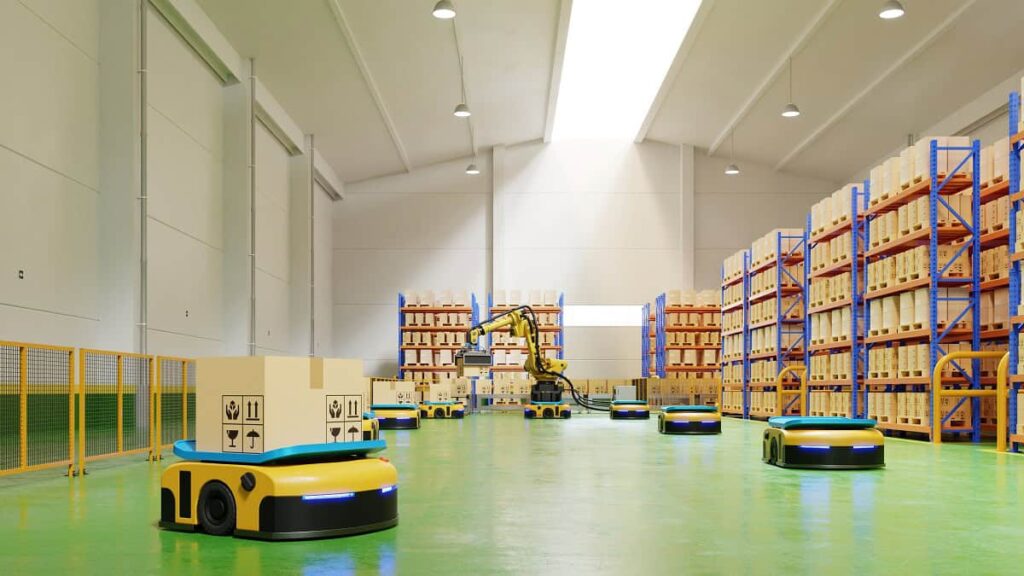पृथ्वी की भूमि एक सीमित संसाधन है। ऐतिहासिक रूप से, हमारे कार्यों और प्रथाओं के प्रभाव या भविष्य की पीढ़ियों के लिए हम किस स्थिति में भूमि छोड़ेंगे - इस पर अब तक बहुत कम विचार किया गया है। उत्पादों की बढ़ती वैश्विक मांग के साथ, विनिर्माण क्षेत्र जल्द ही धीमा नहीं पड़ने वाला है, फिर भी यह दुनिया के शीर्ष प्रदूषकों में से एक बना हुआ है। यह सकारात्मक परिवर्तन लाने और धरती माता की रक्षा में अंतर लाने में भी महत्वपूर्ण भूमिका निभाता है। नेता स्वयं ऐसे परिवर्तन में अग्रणी भूमिका निभा सकते हैं, जिसमें यह भी शामिल है कि वे अपने व्यवसायों के पर्यावरणीय पदचिह्न को कम करने के लिए अपने संचालन के लिए भूमि का उपयोग कैसे करते हैं।
निर्माताओं पर दबाव कम नहीं हो रहा है - यह और भी बढ़ रहा है। दुनिया भर में, यूरोपीय संघ (ईयू) सहित सरकारें सख्त उपाय लागू कर रही हैं जैसे कि यूरोपीय संघ वन-कटान-मुक्त विनियमन (EUDR) जो वनों की कटाई से जुड़े उत्पादों पर प्रतिबंध लगाते हैं। EUDR की तरह, संयुक्त राज्य अमेरिका ने भी "विदेशी कानून और पर्यावरण की दृष्टि से सुदृढ़ व्यापार को बढ़ावा देने" (Fostering Overseas Rule of Law and Environmentally Sound Trade - FOREST) अधिनियम का प्रस्ताव रखा है, जो "अवैध रूप से वनों की कटाई की गई भूमि पर उत्पादित कुछ वस्तुओं को अपने बाज़ार में प्रवेश करने से रोकता है।" ऑस्ट्रेलिया में, औद्योगिक रसायन अधिनियम 2019 औद्योगिक रसायनों के उपयोग और परिचय को नियंत्रित करता है, यह सुनिश्चित करता है कि निर्माता सुरक्षा और पर्यावरणीय मानकों का पालन करें।
भूमि उपयोग से जुड़े वित्तीय जोखिम बढ़ने लगे हैं क्योंकि विभिन्न क्षेत्रों में विनियमनों की संख्या और दायरा बढ़ता जा रहा है। विनियमन विकसित होते रहेंगे, अधिक मजबूत और व्यापक होते जाएंगे, जिससे नेताओं को निर्णायक रूप से कार्य करने की आवश्यकता पर बल मिलेगा। निर्माता इन बदलते विनियमनों या कानूनों से छिप नहीं सकते हैं और उन्हें इन चुनौतियों का सामना करना होगा।
अच्छी खबर यह है कि टिकाऊ भूमि उपयोग नीतियों और माइक्रोफैक्ट्रियों जैसे समाधानों को अपनाकर, निर्माता अतीत की दिशा बदल सकते हैं और सकारात्मक प्रभाव डालना शुरू कर सकते हैं।
स्थिति: विनिर्माण में भूमि उपयोग की वर्तमान स्थिति
भूमि उपयोग को अनुकूलित करने वाले नेताओं के लिए महत्वपूर्ण लाभ हैं, जो उनके पर्यावरणीय पदचिह्न को कम करने, संसाधन दक्षता बढ़ाने और अपने ग्राहकों को यह दिखाने से शुरू होते हैं कि वे वास्तव में पर्यावरण की परवाह करते हैं। भूमि का अधिक प्रभावी ढंग से उपयोग करके, निर्माता विभिन्न विनियमों का पालन करेंगे, अनुपालन करेंगे और जोखिम का प्रबंधन करेंगे, जिससे तेजी से बढ़ते स्थिरता-संचालित बाजार में दीर्घकालिक सफलता सुनिश्चित होगी।
स्मिथसोनियन की एक रिपोर्ट के अनुसार, मनुष्य पृथ्वी के सुदूर क्षेत्रों तक फैल चुका है, हर महाद्वीप पर रह रहा है और ग्रह की व्यवहार्य भूमि सतह के कम से कम 83 प्रतिशत हिस्से को प्रभावित कर रहा है। निर्माताओं को जिम्मेदार भूमि उपयोग सुनिश्चित करना चाहिए, लेकिन भूमि सहित पर्यावरण पर अपने संचालन के किसी भी दीर्घकालिक नकारात्मक प्रभाव को कम करने के लिए भी दूरदर्शी होना चाहिए।
विश्व आर्थिक मंच (WEF) ने कहा है कि "व्यापक भूमि उपयोग और रूपांतरण हमारे ग्रह के स्वास्थ्य के लिए खतरा बन रहे हैं" और पृथ्वी की सतह का तीन-चौथाई हिस्सा पहले ही काफी हद तक परिवर्तित हो चुका है।
जबकि संधारणीय प्रथाओं में प्रारंभिक निवेश महत्वपूर्ण हो सकता है, कुल मिलाकर, जिम्मेदार भूमि उपयोग के कई लाभ हैं, जिसमें अपशिष्ट को कम करके दीर्घावधि में लागत-प्रभावशीलता शामिल है। WEF ने उत्साहजनक अंतर्दृष्टि की भी रिपोर्ट की है कि यदि कंपनियाँ आज भूमि, खाद्य और महासागर-उपयोग प्रणालियों में संधारणीय परिवर्तन को अपनाती हैं, तो वे लगभग 100% उत्पादन कर सकती हैं।वार्षिक मूल्य में $3.6 ट्रिलियन तथा 2030 तक 191 मिलियन नौकरियाँ पैदा होंगी। हालांकि, इस मूल्य को प्राप्त करने के लिए, निर्माताओं को अपनी व्यावसायिक योजना की समीक्षा करनी होगी और अपने पर्यावरण, सामाजिक और शासन (ईएसजी) लक्ष्यों के भीतर भूमि उपयोग को संबोधित करना होगा।
भूमि संरक्षण और इसके उपयोग को अनुकूलतम बनाने के लिए शीर्ष 5 रणनीतियाँ:
जबकि सीईओ अभूतपूर्व परिवर्तन से जूझ रहे हैं, अपने व्यवसाय संचालन में इन व्यावहारिक रणनीतियों को शामिल करके, वे अपने भूमि प्रभाव को कम कर सकते हैं और स्मार्ट विनिर्माण और हरित प्रौद्योगिकियों जैसे अभिनव समाधानों के माध्यम से अपने डिजिटल परिवर्तन प्रयासों को आगे बढ़ा सकते हैं। निर्माताओं के लिए जिम्मेदार भूमि प्रबंधन के लिए पाँच दूरदर्शी दृष्टिकोण शामिल हैं:
1. टिकाऊ सोर्सिंग
निर्माताओं को कच्चे माल की आवश्यकता होती है, लेकिन हमारी भूमि से टिकाऊ स्रोत प्राप्त करने तथा जिम्मेदार भूमि प्रबंधन से इन सामग्रियों के निष्कर्षण और प्रसंस्करण से जुड़े कार्बन उत्सर्जन में कटौती की जा सकती है।
2. भूमि उपयोग योजना
भूमि-उपयोग नियोजन को विनिर्माण के साथ संयोजित करने से पर्यावरणीय प्रभाव को कम करने में मदद मिल सकती है, जैसे साझा संसाधनों, नवीकरणीय ऊर्जा का उपयोग करने वाले कारखानों को डिजाइन करना, तथा प्रभावी अपशिष्ट प्रबंधन से कार्बन उत्सर्जन में कटौती की जा सकती है।
3. कार्बन कैप्चर
स्वस्थ पारिस्थितिकी तंत्र कार्बन को अलग कर सकते हैं। इसके अतिरिक्त, प्रकृति के संरक्षण के लिए अंतर्राष्ट्रीय संघ ने संकेत दिया है कि मिट्टी की सुरक्षा और बहाली 2030 तक वैश्विक तापमान को 1.5˚C से नीचे रखने के लिए आवश्यक सबसे अधिक लागत प्रभावी शमन कार्यों का 33 प्रतिशत से अधिक हिस्सा है।
4. माइक्रोफैक्ट्रियां
उपभोक्ताओं और आपूर्तिकर्ताओं के करीब काम करके, माइक्रोफैक्ट्रियां न केवल लंबी दूरी की परिवहन आवश्यकताओं को कम करते हैं बल्कि पारंपरिक सुविधाओं की तुलना में स्वाभाविक रूप से अधिक टिकाऊ होते हैं, और उनके छोटे पदचिह्न का मतलब है कम भूमि उपयोग। इन कॉम्पैक्ट, हाई-टेक कारखानों में विनिर्माण के भविष्य को नया रूप देने की क्षमता है।
5. स्थान चयन
सीईओ को रणनीतिक रूप से ऐसे विनिर्माण स्थलों का चयन करना चाहिए जो न्यूनतम पर्यावरणीय प्रभाव की गारंटी देते हों। स्वच्छ मिट्टी और आपूर्तिकर्ताओं और बाजारों के निकट स्थानों का चयन करके, वे न केवल परिवहन उत्सर्जन में कटौती कर सकते हैं और प्रदूषकों को पेश करने के जोखिम को कम कर सकते हैं, बल्कि एक अधिक टिकाऊ और कुशल संचालन भी बना सकते हैं।
क्रियाशील भूमि उपयोग - हीडलबर्ग मैटेरियल्स का एक केस अध्ययन
जर्मन हीडलबर्ग मैटेरियल्स एक निर्माण सामग्री संगठन है जो व्यावसायिक उद्देश्यों के लिए उपयोग की जाने वाली भूमि के अस्थायी संरक्षक के रूप में अपनी ज़िम्मेदारी स्वीकार करता है। ज़िम्मेदार प्रबंधकों के रूप में, हीडलबर्ग मैटेरियल्स की ज़िम्मेदार भूमि उपयोग नीति में ज़िम्मेदार भूमि उपयोग के प्रति प्रतिबद्धता, प्रभाव की समझ और रिपोर्टिंग, कॉर्पोरेट रणनीति में एकीकरण, जैव विविधता प्रबंधन, और भूमि मुआवज़ा और प्रतिपूर्ति जैसी विभिन्न पहल शामिल हैं। वे सभी मानवाधिकारों का सम्मान करने और हितधारकों की भागीदारी को बढ़ावा देने का भी प्रयास करते हैं, जिससे ब्रांड की प्रतिष्ठा में सुधार होता है, जिससे मुनाफे में वृद्धि हो सकती है।
भूमि उपभोक्ताओं से लेकर संरक्षणवादियों तक - यह क्षेत्र किस प्रकार भूमि दुरुपयोग को रोक सकता है
संक्षेप में, विनिर्माण क्षेत्र में व्यापक परिवर्तन हो रहा है। यह मुख्य रूप से स्वचालन, कृत्रिम बुद्धिमत्ता (एआई) एकीकरण और सतत गतिविधियों जैसे नवाचारों के साथ-साथ कठोर उत्सर्जन दिशानिर्देशों और अपशिष्ट प्रबंधन रणनीतियों जैसे नियामक बदलावों से प्रेरित है। इन उद्योग चुनौतियों के लिए विनिर्माण क्षेत्र के अग्रणी लोगों से त्वरित सोच और अनुकूलन की आवश्यकता है, जिन्हें इस तथ्य को स्वीकार करना होगा कि परिवर्तन आवश्यक है और यह स्थायी रहेगा। हालाँकि यह कष्टदायक है, इस क्षेत्र को सतत भूमि उपयोग और मृदा संरक्षण पहलों सहित ईएसजी-अनुकूल पहलों को अपनाने के लिए रास्ता बनाना होगा। यह बदलाव न केवल ईएसजी प्रगति को गति देगा, बल्कि नियामक अनुपालन और बाजार प्रतिस्पर्धा से जुड़े जोखिमों को कम कर सकता है, जिससे अंततः व्यवसायों का संरक्षण होगा।
हमारे व्यावहारिक माध्यम से उपभोक्ता स्थिरता उद्योग तत्परता सूचकांक मूल्यांकन, हम आगे बढ़ने के लिए एक नए और स्थायी रास्ते की योजना बनाने हेतु अक्षमताओं को उजागर कर सकते हैं। आपके अनुकूलित COSIRI रोडमैप में विशिष्ट मील के पत्थर, चरण-दर-चरण कार्यवाहियाँ, आवश्यक संसाधन और लक्षित उद्देश्य शामिल होंगे। आप वह नहीं जान सकते जो आप नहीं देख सकते, और COSIRI यह स्पष्ट कर सकता है कि आपकी कंपनी का सबसे अधिक नकारात्मक प्रभाव कहाँ है, जो जोखिम न्यूनीकरण के लिए एक उत्कृष्ट प्रारंभिक बिंदु प्रदान करता है। अधिक जानने के लिए, हमारे साथ बात करें प्रमाणित COSIRI मूल्यांकनकर्ता आज ही अपनी ईएसजी यात्रा को गति प्रदान करें।
विनिर्माण में जिम्मेदार भूमि उपयोग के बारे में अक्सर पूछे जाने वाले प्रश्न
विनिर्माण में उत्तरदायी भूमि उपयोग क्या है?
विनिर्माण में उत्तरदायी भूमि उपयोग में औद्योगिक भूमि की योजना, विकास और प्रबंधन इस प्रकार करना शामिल है जिससे पर्यावरणीय प्रभाव न्यूनतम हो, स्थानीय समुदायों को सहायता मिले, तथा यह स्थायित्व और नियामक लक्ष्यों के साथ संरेखित हो।
औद्योगिक विकास में उत्तरदायी भूमि उपयोग क्यों महत्वपूर्ण है?
औद्योगिक विकास में उत्तरदायी भूमि उपयोग महत्वपूर्ण है क्योंकि यह प्राकृतिक संसाधनों की सुरक्षा करने, प्रदूषण कम करने, पर्यावरण कानूनों का अनुपालन सुनिश्चित करने तथा निर्माताओं के लिए दीर्घकालिक साइट व्यवहार्यता को बढ़ावा देने में मदद करता है।
विनिर्माण क्षेत्र में सतत भूमि विकास के लिए सर्वोत्तम प्रथाएँ क्या हैं?
सर्वोत्तम प्रथाओं में पर्यावरणीय प्रभाव के आधार पर स्थल का चयन, हरित निर्माण सामग्री का उपयोग, प्राकृतिक पारिस्थितिकी तंत्र का संरक्षण, ऊर्जा-कुशल बुनियादी ढांचे का कार्यान्वयन, तथा भूमि उपयोग योजना में वृत्तीय अर्थव्यवस्था के सिद्धांतों को एकीकृत करना शामिल है।
सुविधा विस्तार के दौरान निर्माता भूमि पर पड़ने वाले प्रभाव को कैसे कम कर सकते हैं?
निर्माता मौजूदा औद्योगिक स्थलों का पुनः उपयोग करके, सघन एवं कुशल लेआउट डिजाइन करके, हरित स्थानों को संरक्षित करके, मृदा विघटन को कम करके तथा पर्यावरण अनुकूल निर्माण तकनीकों का उपयोग करके भूमि पर प्रभाव को न्यूनतम कर सकते हैं।
उत्तरदायी भूमि उपयोग ईएसजी अनुपालन का समर्थन कैसे करता है?
जिम्मेदार भूमि उपयोग पर्यावरणीय नुकसान को कम करके (ई), सामुदायिक कल्याण में योगदान देकर (एस), और भूमि विकास निर्णयों को पारदर्शी, नैतिक शासन प्रथाओं के साथ संरेखित करके (जी) ईएसजी अनुपालन का समर्थन करता है।
विनिर्माण क्षेत्र में भूमि उपयोग की खराब योजना के पर्यावरणीय जोखिम क्या हैं?
भूमि उपयोग की खराब योजना से मृदा प्रदूषण, जल प्रदूषण, जैव विविधता का ह्रास और कार्बन उत्सर्जन में वृद्धि हो सकती है। ये जोखिम पारिस्थितिक तंत्र को नुकसान पहुँचा सकते हैं और निर्माताओं पर कानूनी और वित्तीय दंड का कारण बन सकते हैं।
भूमि नियोजन में निर्माता हरित अवसंरचना का उपयोग कैसे कर सकते हैं?
निर्माता पर्यावरणीय प्रभाव को कम करने और टिकाऊ भूमि उपयोग को बढ़ावा देने के लिए वर्षा उद्यान, पारगम्य फुटपाथ, हरित छत, प्राकृतिक बफर्स और ऊर्जा-कुशल जल निकासी प्रणालियों जैसे हरित बुनियादी ढांचे का उपयोग कर सकते हैं।
जिम्मेदार भूमि उपयोग में विनियामक अनुपालन की क्या भूमिका है?
नियामक अनुपालन यह सुनिश्चित करता है कि भूमि विकास पर्यावरण कानूनों, ज़ोनिंग विनियमों और स्थिरता मानकों का पालन करे। यह निर्माताओं को दंड से बचने में मदद करता है और सुरक्षित, अधिक ज़िम्मेदार भूमि उपयोग प्रथाओं में योगदान देता है।


